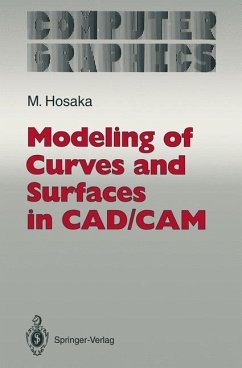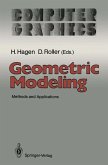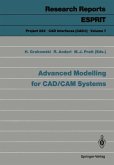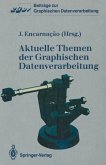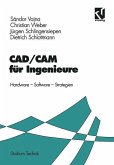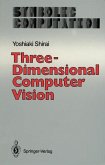Mamoru Hosaka
Modeling of Curves and Surfaces in CAD/CAM
Mamoru Hosaka
Modeling of Curves and Surfaces in CAD/CAM
- Broschiertes Buch
- Merkliste
- Auf die Merkliste
- Bewerten Bewerten
- Teilen
- Produkt teilen
- Produkterinnerung
- Produkterinnerung
1 Aims and Features of This Book The contents of t. his book were originally planned t. o be included in a book en titled Geometric lIIodeling and CAD/CAM to be written by M. Hosaka and F. Kimura, but since the draft. of my part of the book was finished much earlier than Kimura's, we decided to publish this part separately at first. In it, geometrically oriented basic methods and tools used for analysis and synthesis of curves and surfaces used in CAD/CAM, various expressions and manipulations of free-form surface patches and their connection, interference as well as their qualit. y eval…mehr
Andere Kunden interessierten sich auch für
![Geometric Modeling Geometric Modeling]() Geometric Modeling77,99 €
Geometric Modeling77,99 €![Advanced Modelling for CAD/CAM Systems Advanced Modelling for CAD/CAM Systems]() Advanced Modelling for CAD/CAM Systems38,99 €
Advanced Modelling for CAD/CAM Systems38,99 €![Aktuelle Themen der Graphischen Datenverarbeitung Aktuelle Themen der Graphischen Datenverarbeitung]() Aktuelle Themen der Graphischen Datenverarbeitung54,99 €
Aktuelle Themen der Graphischen Datenverarbeitung54,99 €![CAM CAM]() CAM77,99 €
CAM77,99 €![CAD/CAM für Ingenieure CAD/CAM für Ingenieure]() Sándor VajnaCAD/CAM für Ingenieure49,99 €
Sándor VajnaCAD/CAM für Ingenieure49,99 €![Three-Dimensional Computer Vision Three-Dimensional Computer Vision]() Yoshiaki ShiraiThree-Dimensional Computer Vision77,99 €
Yoshiaki ShiraiThree-Dimensional Computer Vision77,99 €![Specification of a CAD * I Neutral File for CAD Geometry Specification of a CAD * I Neutral File for CAD Geometry]() Specification of a CAD * I Neutral File for CAD Geometry77,99 €
Specification of a CAD * I Neutral File for CAD Geometry77,99 €-
-
-
1 Aims and Features of This Book The contents of t. his book were originally planned t. o be included in a book en titled Geometric lIIodeling and CAD/CAM to be written by M. Hosaka and F. Kimura, but since the draft. of my part of the book was finished much earlier than Kimura's, we decided to publish this part separately at first. In it, geometrically oriented basic methods and tools used for analysis and synthesis of curves and surfaces used in CAD/CAM, various expressions and manipulations of free-form surface patches and their connection, interference as well as their qualit. y eval uation are treated. They are important elements and procedures of geometric models. And construction and utilization of geometric models which include free-form surfaces are explained in the application examples, in which the meth ods and the techniques described in this book were used. In the succeeding book which Kimura is to write, advanced topics such as data structures of geometric models, non-manifold models, geometric inference as well as tolerance problems and product models, process planning and so on are to be included. Conse quently, the title of this book is changed to Modeling of Curves and Surfaces in CAD/CAM. Features of this book are the following. Though there are excellent text books in the same field such as G. Farin's Curves and Surfaces for CAD /CAM[l] and C. M.
Hinweis: Dieser Artikel kann nur an eine deutsche Lieferadresse ausgeliefert werden.
Hinweis: Dieser Artikel kann nur an eine deutsche Lieferadresse ausgeliefert werden.
Produktdetails
- Produktdetails
- Computer Graphics: Systems and Applications
- Verlag: Springer / Springer Berlin Heidelberg / Springer, Berlin
- Artikelnr. des Verlages: 978-3-642-76600-8
- Softcover reprint of the original 1st ed. 1992
- Seitenzahl: 380
- Erscheinungstermin: 23. Dezember 2011
- Englisch
- Abmessung: 235mm x 155mm x 21mm
- Gewicht: 576g
- ISBN-13: 9783642766008
- ISBN-10: 3642766005
- Artikelnr.: 36116489
- Herstellerkennzeichnung
- Springer-Verlag GmbH
- Tiergartenstr. 17
- 69121 Heidelberg
- ProductSafety@springernature.com
- Computer Graphics: Systems and Applications
- Verlag: Springer / Springer Berlin Heidelberg / Springer, Berlin
- Artikelnr. des Verlages: 978-3-642-76600-8
- Softcover reprint of the original 1st ed. 1992
- Seitenzahl: 380
- Erscheinungstermin: 23. Dezember 2011
- Englisch
- Abmessung: 235mm x 155mm x 21mm
- Gewicht: 576g
- ISBN-13: 9783642766008
- ISBN-10: 3642766005
- Artikelnr.: 36116489
- Herstellerkennzeichnung
- Springer-Verlag GmbH
- Tiergartenstr. 17
- 69121 Heidelberg
- ProductSafety@springernature.com
1 Excerpts from Vector and Matrix Theory.- 1.1 Introduction.- 1.2 Notations of Vectors and Vector Arithmetic.- 1.3 Product of Vectors.- 1.3.1 Inner Product of Vectors.- 1.3.2 Vector Product.- 1.4 Triple Products.- 1.4.1 Scalar Triple Product.- 1.4.2 Vector Triple Product.- 1.4.3 Application Examples.- 1.4.4 Oblique Coordinate System.- 1.5 Differentiation of Vectors.- 1.6 Matrix Notations and Simple Arithmetic of Matrices.- 1.7 Products of Matrices.- 1.7.1 Multiplication of a Vector and a Matrix.- 1.7.2 Product of Matrices.- 1.8 Square Matrix, Inverse Matrix and Other Related Matrices.- 1.9 Principal Directions and Eigenvalues.- 2 Coordinate Transformations and Displacements.- 2.1 Introduction.- 2.2 Coordinate Transformation Matrix 1.- 2.3 Calculation of Transformation Matrix.- 2.4 Coordinate Transformation Matrix 2.- 2.5 Movement and Coordinate Transformations.- 2.6 Application Examples.- 2.6.1 Successive Rotations in Space.- 2.6.2 Rotation of a Body Around a Line in Space.- 2.6.3 Calculation of Geometric Constraints.- 2.7 Expressions of Movement of a Body by Reflection.- 2.7.1 Translation.- 2.7.2 Rotation Around an Axis.- 2.7.3 Movement by Four Mirrors.- 2.7.4 Determination of Screw Axis, Rotation Angle and Translation Distance.- 2.7.5 Displacement Matrix S and Mirror Matrix M.- 3 Lines, Planes and Polyhedra.- 3.1 Introduction.- 3.2 Equations of Straight Line and Intersection of Line Segments.- 3.3 Control Polygons and Menelaus' Theorem.- 3.4 Equations of Plane and Intersection of Line and Plane.- 3.5 Polyhedron and Its Geometric Properties 1.- 3.6 Polyhedron and Its Geometric Properties 2.- 3.7 Interference of Polyhedra.- 3.8 Local Operations for Deformation of Polyhedron.- 4 Conics and Quadrics.- 4.1 Introduction.- 4.2 Conics.- 4.2.1 Equation of Conics.- 4.2.2Transformation of Equation.- 4.2.3 Classification of Conics.- 4.2.4 Intersection of Conics.- 4.3 Quadrics.- 4.3.1 Coordinate Transformation.- 4.3.2 Classification.- 4.4 Intersection of Two Quadrics.- 5 Theory of Curves.- 5.1 Introduction.- 5.2 Tangent and Curvature of Curve.- 5.3 Binormal and Torsion of Curve.- 5.4 Expressions with Parameter t.- 5.5 Curvature of Space Curve and Its Projection.- 5.6 Implicit Expression of a Parametric Curve.- 6 Basic Theory of Surfaces.- 6.1 Introduction.- 6.2 The Basic Vectors and the Fundamental Magnitudes.- 6.3 Normal Section and Normal Curvature.- 6.4 Principal Curvatures.- 6.5 Principal Directions and Lines of Curvature.- 6.6 Derivatives of a Unit Normal and Rodrigues' Formula.- 6.7 Local Shape of Surface.- 7 Advanced Applications of Theory of Surfaces.- 7.1 Introduction.- 7.2 Umbilics.- 7.3 Characteristic Curves on a Surface 1.- 7.3.1 General Remarks.- 7.3.2 Lines of Curvature.- 7.3.3 Extremum Search Curves.- 7.3.4 Contour Curves and Their Orthogonal Curves.- 7.3.5 Equi-gradient Curves.- 7.3.6 Silhouette Curve and Silhouette Pattern.- 7.3.7 Highlight Curves.- 7.4 Characteristic Curves on a Surface 2.- 7.4.1 Gradient Extremum Curves or Ridge-Valley Curves.- 7.4.2 Loci of Zero Gaussian Curvature and Loci of Extremum Principal Curvatures.- 7.5 Offset Surfaces.- 7.6 Ruled Surfaces.- 8 Curves Through Given Points, Interpolation and Extrapolation.- 8.1 Introduction.- 8.2 Polynomial and Rational Interpolation and Extrapolation.- 8.2.1 Lagrange's Formula.- 8.2.2 Numerical Methods of Interpolated Points.- 8.2.3 Rational Function Interpolation and Extrapolation.- 8.3 Polynomial Interpolation with Constraints of Derivatives.- 8.4 Elastic Curves with Minimum Energy.- 8.5 Interpolation by Parametric Curves.- 8.6 Appendix. Derivation ofEquations by Elastic Beam Analogy.- 9 Bézier Curves and Control Points.- 9.1 Introduction.- 9.2 Curve Segment and Its Control Points.- 9.3 Bézier Curve and Its Operator Form.- 9.4 Different Expressions of B Curve.- 9.5 Derivatives at Ends of a Segment and Hodographs.- 9.6 Geometric Properties of B Curve.- 9.7 Division of a Curve Segment and Its B Polygon.- 9.8 Continuity Conditions of Connection of B Polygons.- 9.9 Elevation of Degree of a Curve Segment.- 9.10 Expression for a Surface Patch.- 9.11 Geometric Properties of a Patch.- 9.12 Division and Degree Elevation of a Patch.- 9.13 Appendix. The Original Form of the Bézier Curve.- 10 Connection of Bézier Curves and Relation to Spline Polygons.- 10.1 Introduction.- 10.2 Connection of B Curve Segments.- 10.2.1 Scale Ratios.- 10.2.2 Conditions of C(i) Connection.- 10.2.3 C(n-1) Connection and Control Points.- 10.2.4 Connection Defining Polygon.- 10.3 Introduction of S Polygon.- 10.3.1 Locating B Points from an S Polygon.- 10.3.2 Increase of Vertices of an S Polygon.- 10.4 B points under Geometric Connecting Condition G(2).- 10.5 Curvature Profile Problem in Design.- 10.5.1 Geometric interpretation of Dividing Ratios.- 10.5.2 Control of Curvature Distribution of Connected Curves.- 11 Connection of Bézier Patches and Geometry of Spline Polygons and Nets.- 11.1 Introduction.- 11.2 Spline Nets and Connected Bézier Nets.- 11.2.1 Tensor Product Surfaces.- 11.2.2 Division of an S Net.- 11.3 Geometric Structure of S Polygons.- 11.4 Menelaus Edges and Their Dividing Points.- 11.4.1 Dividing Points and Sub-edges.- 11.4.2 Relations Among Dividing Points and Menelaus Edges.- 11.5 Derivation of B Polygons from an S Polygon.- 11.5.1 Reduced S Polygons.- 11.5.2 Examples.- 11.5.3 Locating B Polygons from Reduced-Truncated SPolygons.- 11.5.4 Division of an S Polygon and Insertion of a Vertex.- 11.6 General Formulas for Locations of B Points.- 11.6.1 Rules of Location Symbols of B Points and Their Properties.- 11.6.1.1 Level of Menelaus Edges and Dividing Points.- 11.6.1.2 Symbols for Location of Control Points.- 11.6.2 General Expressions of B Point Locations.- 11.6.2.1 Application of Location Symbols.- 11.6.2.2 Formulas for Location Symbols.- 11.6.2.3 Level of Edges of a B Polygon.- 11.7 Appendix. Orthodox Approach to a B Spline Curve.- 12 Rational Bézier and Spline Expressions.- 12.1 Introduction.- 12.2 Rational Bézier Curves.- 12.2.1 Rational Division Between Two Points and Its Perspective Map.- 12.2.2 Rational Bézier Curves and Their Canonical Perspectives.- 12.2.3 Effects of Weights.- 12.2.4 Division and Degree Elevation.- 12.2.5 Derivatives at Ends of a Segment.- 12.3 Rational Bézier Patches.- 12.4 Rational Splines.- 12.4.1 Rational B Polygons from a Rational S Polygon.- 12.4.2 G(2) Connection of Curves from a Rational S Polygon.- 12.5 Rational Spline Nets and Bézier Nets.- 12.6 Expressions for Conics.- 12.6.1 Conversion to an Implicit Form.- 12.6.2 Classification by Weight.- 12.6.3 Sphere and Surface of Revolution.- 12.7 Interpolation and Extrapolation with Conics.- 12.7.1 Weight of a Control Point and Parameter Values.- 12.7.2 Division of a Rational Polygon.- 12.7.3 Extension of a Curve Segment.- 12.7.4 Distance Between a Conic and a Point Near It.- 12.7.5 Curve Fitting by Conics.- 13 Non-regular Connections of Four-Sided Patches and Roundings of Corners.- 13.1 Introduction.- 13.2 General C(1) Connection of B Patches.- 13.3 Example of Closed Surface of Minimum Number of Patches.- 13.4 Three or Five-Sided Patch in Regular Patch Nets.- 13.4.1 Rounding of a Convex Region.-13.4.2 Rounding of a Convex-Concave Mixed Region 1.- 13.5 Rounding of a Convex-Conecave Mixed Region 2.- 13.6 Rounding with a Rolling Ball.- 13.7 Appendix.- 13.7.1 Connection in a Triangular Region: General Case.- 13.7.2 Connection of a Pentagonal Region: General Case.- 14 Connections of Patches by Blending.- 14.1 Introduction.- 14.2 Coons' Patch.- 14.3 Independent Boundary Conditions.- 14.3.1 Blending by Weighted Sum.- 14.3.2 Two-Valued Twist Vectors and Floating Inner Control Points.- 14.4 Correction of Cross-Boundary Tangent Vectors.- 14.4.1 Connection of Four-Sided Patches.- 14.4.2 Evaluation and Comparison of Methods.- 14.4.3 Three-Sided Patches.- 14.5 Case of C(2) Connection.- 14.5.1 Four-Sided Patches.- 14.5.2 Three-Sided Patches.- 15 Triangular Surface Patches and Their Connection.- 15.1 Introduction.- 15.2 Operator Form of a Triangular Patch.- 15.2.1 Triangular Bézier Patches.- 15.2.2 Rational Triangular Patches.- 15.2.3 Tangents on Patch Boundaries.- 15.3 C(1) Connection of Triangular Patches.- 15.4 Arbitrary Connection of Three-Sided Patches.- 15.5 Division of a Triangular Patch.- 15.6 Elevation of Degree.- 16 Surface Intersections.- 16.1 Introduction.- 16.2 Intersection of a Curved Surface and a Plane.- 16.2.1 General Remarks.- 16.2.2 A Practical Method of Obtaining a Point on an IntersectionCurve.- 16.2.3 Curve Tracing by Differential Equation Solving.- 16.3 Points on Intersection of Two Curved Surfaces.- 16.3.1 General Remarks.- 16.3.2 Method with an Auxiliary Plane.- 16.3.3 Initial Starting Points and Critical Contact Points.- 16.3.3.1 Detection of Intersection Loops.- 16.3.3.2 Critical Points.- 16.4 Intersection Curves Described by Differential Equations.- 16.4.1 Both Surfaces with Parametric Expressions.- 16.4.2 Surfaces with Implicit and ParametricExpressions.- 16.4.3 Both Surfaces with Implicit Expressions.- 16.5 Intersection Near a Probable Singular Point.- 16.6 Intersection of Offset Surfaces.- 16.6.1 Intersection with a Plane.- 16.6.2 Intersection of Two Offset Surfaces.- 16.6.2.1 Two Parametric Surfaces.- 16.6.2.2 A Parametric Surface and a Surface of Implicit Form.- 16.6.2.3 Two Surfaces with Implicit Expressions.- 17 Applications of the Theories in Industry.- 17.1 Introduction.- 17.2 Engineering Drawings and Geometric Models.- 17.3 Examples of Integration.- 17.3.1 Conventional processes.- 17.3.2 New Integrated Processes.- 17.4 Style Design System.- 17.4.1 Importance of Shape Design.- 17.4.2 Two Aspects of Style Design.- 17.4.3 Computer-Aided Style Design.- 17.4.3.1 Input of Simplified Drawings.- 17.4.3.2 Classes and Types of Surfaces in Style Design of Motor Cars.- 17.4.3.3 Evaluation of Curve and Surface Quality.- 17.4.4 Die-Face Design System.- 17.5 CAD/CAM of Free-Form Injection-Mold Products.- Appendix. Numerical Methods of Differential Equation Solving.- A.1 Introduction.- A.2 Adaptive Runge-Kutta Method.- A.2.1 Runge-Kutta Step.- A.2.2 Runge-Kutta with Quality Control.- A.2.3 Runge-Kutta-Fehlberg Method.- A.3 Variable Stepsize Predictor-Corrector Method.- A.4 Bulirsch-Stoer Method.- A.4.1 Principle of the Method.- A.4.2 Outline of the Procedures.- A.4.3 Integration Procedure.- A.4.4 Polynomial Extrapolation.- A.4.5 Rational Extrapolation.- A.5 Examples and Evaluation.
1 Excerpts from Vector and Matrix Theory.- 1.1 Introduction.- 1.2 Notations of Vectors and Vector Arithmetic.- 1.3 Product of Vectors.- 1.3.1 Inner Product of Vectors.- 1.3.2 Vector Product.- 1.4 Triple Products.- 1.4.1 Scalar Triple Product.- 1.4.2 Vector Triple Product.- 1.4.3 Application Examples.- 1.4.4 Oblique Coordinate System.- 1.5 Differentiation of Vectors.- 1.6 Matrix Notations and Simple Arithmetic of Matrices.- 1.7 Products of Matrices.- 1.7.1 Multiplication of a Vector and a Matrix.- 1.7.2 Product of Matrices.- 1.8 Square Matrix, Inverse Matrix and Other Related Matrices.- 1.9 Principal Directions and Eigenvalues.- 2 Coordinate Transformations and Displacements.- 2.1 Introduction.- 2.2 Coordinate Transformation Matrix 1.- 2.3 Calculation of Transformation Matrix.- 2.4 Coordinate Transformation Matrix 2.- 2.5 Movement and Coordinate Transformations.- 2.6 Application Examples.- 2.6.1 Successive Rotations in Space.- 2.6.2 Rotation of a Body Around a Line in Space.- 2.6.3 Calculation of Geometric Constraints.- 2.7 Expressions of Movement of a Body by Reflection.- 2.7.1 Translation.- 2.7.2 Rotation Around an Axis.- 2.7.3 Movement by Four Mirrors.- 2.7.4 Determination of Screw Axis, Rotation Angle and Translation Distance.- 2.7.5 Displacement Matrix S and Mirror Matrix M.- 3 Lines, Planes and Polyhedra.- 3.1 Introduction.- 3.2 Equations of Straight Line and Intersection of Line Segments.- 3.3 Control Polygons and Menelaus' Theorem.- 3.4 Equations of Plane and Intersection of Line and Plane.- 3.5 Polyhedron and Its Geometric Properties 1.- 3.6 Polyhedron and Its Geometric Properties 2.- 3.7 Interference of Polyhedra.- 3.8 Local Operations for Deformation of Polyhedron.- 4 Conics and Quadrics.- 4.1 Introduction.- 4.2 Conics.- 4.2.1 Equation of Conics.- 4.2.2Transformation of Equation.- 4.2.3 Classification of Conics.- 4.2.4 Intersection of Conics.- 4.3 Quadrics.- 4.3.1 Coordinate Transformation.- 4.3.2 Classification.- 4.4 Intersection of Two Quadrics.- 5 Theory of Curves.- 5.1 Introduction.- 5.2 Tangent and Curvature of Curve.- 5.3 Binormal and Torsion of Curve.- 5.4 Expressions with Parameter t.- 5.5 Curvature of Space Curve and Its Projection.- 5.6 Implicit Expression of a Parametric Curve.- 6 Basic Theory of Surfaces.- 6.1 Introduction.- 6.2 The Basic Vectors and the Fundamental Magnitudes.- 6.3 Normal Section and Normal Curvature.- 6.4 Principal Curvatures.- 6.5 Principal Directions and Lines of Curvature.- 6.6 Derivatives of a Unit Normal and Rodrigues' Formula.- 6.7 Local Shape of Surface.- 7 Advanced Applications of Theory of Surfaces.- 7.1 Introduction.- 7.2 Umbilics.- 7.3 Characteristic Curves on a Surface 1.- 7.3.1 General Remarks.- 7.3.2 Lines of Curvature.- 7.3.3 Extremum Search Curves.- 7.3.4 Contour Curves and Their Orthogonal Curves.- 7.3.5 Equi-gradient Curves.- 7.3.6 Silhouette Curve and Silhouette Pattern.- 7.3.7 Highlight Curves.- 7.4 Characteristic Curves on a Surface 2.- 7.4.1 Gradient Extremum Curves or Ridge-Valley Curves.- 7.4.2 Loci of Zero Gaussian Curvature and Loci of Extremum Principal Curvatures.- 7.5 Offset Surfaces.- 7.6 Ruled Surfaces.- 8 Curves Through Given Points, Interpolation and Extrapolation.- 8.1 Introduction.- 8.2 Polynomial and Rational Interpolation and Extrapolation.- 8.2.1 Lagrange's Formula.- 8.2.2 Numerical Methods of Interpolated Points.- 8.2.3 Rational Function Interpolation and Extrapolation.- 8.3 Polynomial Interpolation with Constraints of Derivatives.- 8.4 Elastic Curves with Minimum Energy.- 8.5 Interpolation by Parametric Curves.- 8.6 Appendix. Derivation ofEquations by Elastic Beam Analogy.- 9 Bézier Curves and Control Points.- 9.1 Introduction.- 9.2 Curve Segment and Its Control Points.- 9.3 Bézier Curve and Its Operator Form.- 9.4 Different Expressions of B Curve.- 9.5 Derivatives at Ends of a Segment and Hodographs.- 9.6 Geometric Properties of B Curve.- 9.7 Division of a Curve Segment and Its B Polygon.- 9.8 Continuity Conditions of Connection of B Polygons.- 9.9 Elevation of Degree of a Curve Segment.- 9.10 Expression for a Surface Patch.- 9.11 Geometric Properties of a Patch.- 9.12 Division and Degree Elevation of a Patch.- 9.13 Appendix. The Original Form of the Bézier Curve.- 10 Connection of Bézier Curves and Relation to Spline Polygons.- 10.1 Introduction.- 10.2 Connection of B Curve Segments.- 10.2.1 Scale Ratios.- 10.2.2 Conditions of C(i) Connection.- 10.2.3 C(n-1) Connection and Control Points.- 10.2.4 Connection Defining Polygon.- 10.3 Introduction of S Polygon.- 10.3.1 Locating B Points from an S Polygon.- 10.3.2 Increase of Vertices of an S Polygon.- 10.4 B points under Geometric Connecting Condition G(2).- 10.5 Curvature Profile Problem in Design.- 10.5.1 Geometric interpretation of Dividing Ratios.- 10.5.2 Control of Curvature Distribution of Connected Curves.- 11 Connection of Bézier Patches and Geometry of Spline Polygons and Nets.- 11.1 Introduction.- 11.2 Spline Nets and Connected Bézier Nets.- 11.2.1 Tensor Product Surfaces.- 11.2.2 Division of an S Net.- 11.3 Geometric Structure of S Polygons.- 11.4 Menelaus Edges and Their Dividing Points.- 11.4.1 Dividing Points and Sub-edges.- 11.4.2 Relations Among Dividing Points and Menelaus Edges.- 11.5 Derivation of B Polygons from an S Polygon.- 11.5.1 Reduced S Polygons.- 11.5.2 Examples.- 11.5.3 Locating B Polygons from Reduced-Truncated SPolygons.- 11.5.4 Division of an S Polygon and Insertion of a Vertex.- 11.6 General Formulas for Locations of B Points.- 11.6.1 Rules of Location Symbols of B Points and Their Properties.- 11.6.1.1 Level of Menelaus Edges and Dividing Points.- 11.6.1.2 Symbols for Location of Control Points.- 11.6.2 General Expressions of B Point Locations.- 11.6.2.1 Application of Location Symbols.- 11.6.2.2 Formulas for Location Symbols.- 11.6.2.3 Level of Edges of a B Polygon.- 11.7 Appendix. Orthodox Approach to a B Spline Curve.- 12 Rational Bézier and Spline Expressions.- 12.1 Introduction.- 12.2 Rational Bézier Curves.- 12.2.1 Rational Division Between Two Points and Its Perspective Map.- 12.2.2 Rational Bézier Curves and Their Canonical Perspectives.- 12.2.3 Effects of Weights.- 12.2.4 Division and Degree Elevation.- 12.2.5 Derivatives at Ends of a Segment.- 12.3 Rational Bézier Patches.- 12.4 Rational Splines.- 12.4.1 Rational B Polygons from a Rational S Polygon.- 12.4.2 G(2) Connection of Curves from a Rational S Polygon.- 12.5 Rational Spline Nets and Bézier Nets.- 12.6 Expressions for Conics.- 12.6.1 Conversion to an Implicit Form.- 12.6.2 Classification by Weight.- 12.6.3 Sphere and Surface of Revolution.- 12.7 Interpolation and Extrapolation with Conics.- 12.7.1 Weight of a Control Point and Parameter Values.- 12.7.2 Division of a Rational Polygon.- 12.7.3 Extension of a Curve Segment.- 12.7.4 Distance Between a Conic and a Point Near It.- 12.7.5 Curve Fitting by Conics.- 13 Non-regular Connections of Four-Sided Patches and Roundings of Corners.- 13.1 Introduction.- 13.2 General C(1) Connection of B Patches.- 13.3 Example of Closed Surface of Minimum Number of Patches.- 13.4 Three or Five-Sided Patch in Regular Patch Nets.- 13.4.1 Rounding of a Convex Region.-13.4.2 Rounding of a Convex-Concave Mixed Region 1.- 13.5 Rounding of a Convex-Conecave Mixed Region 2.- 13.6 Rounding with a Rolling Ball.- 13.7 Appendix.- 13.7.1 Connection in a Triangular Region: General Case.- 13.7.2 Connection of a Pentagonal Region: General Case.- 14 Connections of Patches by Blending.- 14.1 Introduction.- 14.2 Coons' Patch.- 14.3 Independent Boundary Conditions.- 14.3.1 Blending by Weighted Sum.- 14.3.2 Two-Valued Twist Vectors and Floating Inner Control Points.- 14.4 Correction of Cross-Boundary Tangent Vectors.- 14.4.1 Connection of Four-Sided Patches.- 14.4.2 Evaluation and Comparison of Methods.- 14.4.3 Three-Sided Patches.- 14.5 Case of C(2) Connection.- 14.5.1 Four-Sided Patches.- 14.5.2 Three-Sided Patches.- 15 Triangular Surface Patches and Their Connection.- 15.1 Introduction.- 15.2 Operator Form of a Triangular Patch.- 15.2.1 Triangular Bézier Patches.- 15.2.2 Rational Triangular Patches.- 15.2.3 Tangents on Patch Boundaries.- 15.3 C(1) Connection of Triangular Patches.- 15.4 Arbitrary Connection of Three-Sided Patches.- 15.5 Division of a Triangular Patch.- 15.6 Elevation of Degree.- 16 Surface Intersections.- 16.1 Introduction.- 16.2 Intersection of a Curved Surface and a Plane.- 16.2.1 General Remarks.- 16.2.2 A Practical Method of Obtaining a Point on an IntersectionCurve.- 16.2.3 Curve Tracing by Differential Equation Solving.- 16.3 Points on Intersection of Two Curved Surfaces.- 16.3.1 General Remarks.- 16.3.2 Method with an Auxiliary Plane.- 16.3.3 Initial Starting Points and Critical Contact Points.- 16.3.3.1 Detection of Intersection Loops.- 16.3.3.2 Critical Points.- 16.4 Intersection Curves Described by Differential Equations.- 16.4.1 Both Surfaces with Parametric Expressions.- 16.4.2 Surfaces with Implicit and ParametricExpressions.- 16.4.3 Both Surfaces with Implicit Expressions.- 16.5 Intersection Near a Probable Singular Point.- 16.6 Intersection of Offset Surfaces.- 16.6.1 Intersection with a Plane.- 16.6.2 Intersection of Two Offset Surfaces.- 16.6.2.1 Two Parametric Surfaces.- 16.6.2.2 A Parametric Surface and a Surface of Implicit Form.- 16.6.2.3 Two Surfaces with Implicit Expressions.- 17 Applications of the Theories in Industry.- 17.1 Introduction.- 17.2 Engineering Drawings and Geometric Models.- 17.3 Examples of Integration.- 17.3.1 Conventional processes.- 17.3.2 New Integrated Processes.- 17.4 Style Design System.- 17.4.1 Importance of Shape Design.- 17.4.2 Two Aspects of Style Design.- 17.4.3 Computer-Aided Style Design.- 17.4.3.1 Input of Simplified Drawings.- 17.4.3.2 Classes and Types of Surfaces in Style Design of Motor Cars.- 17.4.3.3 Evaluation of Curve and Surface Quality.- 17.4.4 Die-Face Design System.- 17.5 CAD/CAM of Free-Form Injection-Mold Products.- Appendix. Numerical Methods of Differential Equation Solving.- A.1 Introduction.- A.2 Adaptive Runge-Kutta Method.- A.2.1 Runge-Kutta Step.- A.2.2 Runge-Kutta with Quality Control.- A.2.3 Runge-Kutta-Fehlberg Method.- A.3 Variable Stepsize Predictor-Corrector Method.- A.4 Bulirsch-Stoer Method.- A.4.1 Principle of the Method.- A.4.2 Outline of the Procedures.- A.4.3 Integration Procedure.- A.4.4 Polynomial Extrapolation.- A.4.5 Rational Extrapolation.- A.5 Examples and Evaluation.

